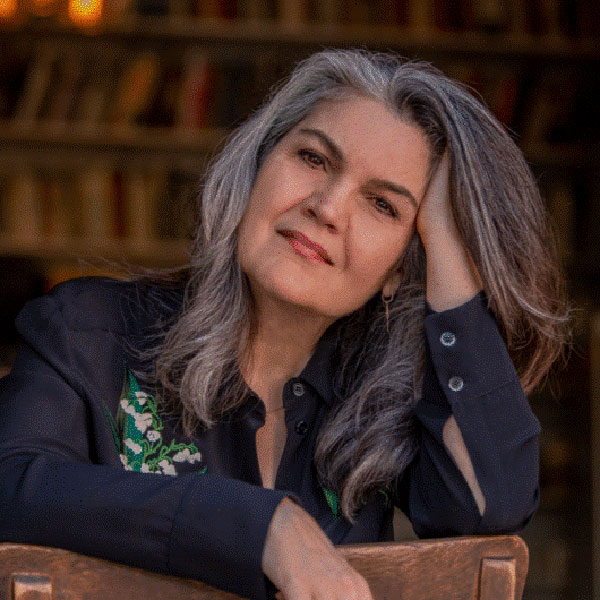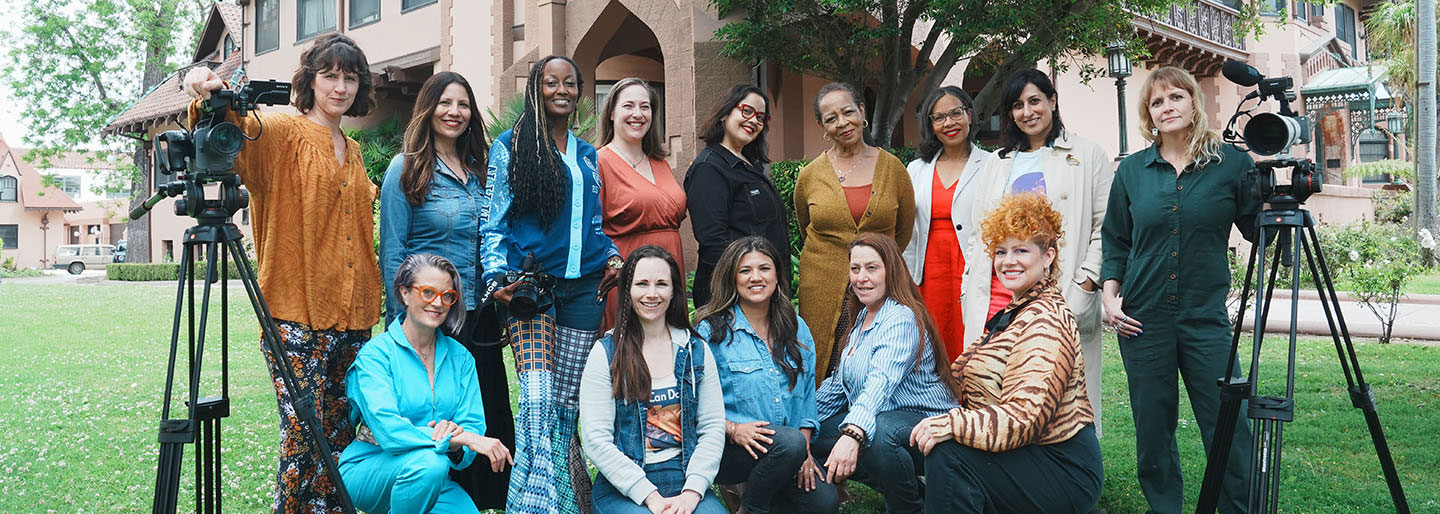During the more than four decades that she has worked as a professional writer, producer, director, and playwright, WGAW member Julie Hébert has recounted plenty of stories. But it was the tale of a remarkable person, a name on the side of the building she didn’t know—but felt she should—that launched the Writers Guild Award- and Emmy Award-nominated Hébert into a unique second act.
Hébert made a short film about Clara Shortridge Foltz, the first female attorney in California and the founder of the American public defender movement. Kicked out of law school in the 1880s (because, as Hébert learned, she was “too distracting to the men,”) she eventually passed the Bar even without a law degree. Foltz went on to help institute the public defender program in California. When in her 80s, she became the first woman to run for governor in California.
 Look What SHE Did! Founding Artistic Director Julie Hébert
Look What SHE Did! Founding Artistic Director Julie Hébert“Here’s this kind of mind-blowing woman who we had never heard of. So Jill Klein and I said, ‘What can we do?’” recalled Hébert, whose credits include The West Wing, The Good Wife, and the film Ruby’s Bucket of Blood. “If there is somebody this important and this accomplished who has been left out of history more or less, how many other women do we not know about that we should know about? That’s a vast problem. What can we do? What we can do is make a little film about Clara and put it on YouTube.”
Which Hébert did, but she didn’t stop with Foltz. Through Look What SHE Did! (LWSD), the nonprofit Hébert founded, a community of storytellers has now created more than 100 films designed to celebrate the achievements of remarkable and often overlooked women. What began as a “backyard art project,” with Hébert, co-founder Jill Klein and friends spending a weekend in a yard filming interviews with a borrowed camera, has evolved into an organization that establishes multiple creative partnerships and looks to uplift women both past and present.
“I would like everyone at the WGA to think what woman they would want to tell the world about. That’s always my question,” Hébert said. “Who is somebody who means a lot to you that has done something amazing that the world should know about? We’ve had multiple writers, directors, and actresses look at our collection and say, ‘That should be a movie or a TV show. I could write that.’ So think of us as a source for material of incredible stories about women.”
LWSD films feature a storyteller introducing and sharing the achievements of her selected hero. Grouping them into an array of categories ranging from L.A. artists to Black women, AAPI, Latinas, authors, performers, pilots, political women, and “women who dissent,” LWSD’s website is a treasure trove of glass ceiling-breakers.

We’ve seen over and over again that representation matters and knowing what’s possible really opens people’s eyes to the possibility of careers, the possibility of actually affecting change.
- Dana Stevens
Several WGAW members have taken a turn in front of the camera to celebrate heroic women. In conducting research for LWSD inspiration, writer-producer Dee Johnson (Fellow Travelers and Nashville) came across Mary Edwards Walker, a doctor who served in the American Civil War and became the only woman to win the Medal of Honor. Johnson saw a photo of Walker wearing pants, and found herself instantly intrigued.
“Here’s a woman who totally defied convention in every way, including looking at clothing sort of as a function forward rather than fashion because the kind of work she did, of course it’s going to be more comfortable in pants,” Johnson said. “She was basically on the front lines, a doctor who was made to be a nurse even though she was a surgeon. I thought she was an intriguing character and I had never heard of her.”
Walker’s story was among 10 LWSD films licensed by Partnership Media to highlight the release of the 2018 Ruth Bader Ginsburg documentary RBG, and has since become the most-watched film in the LWSD collection. The organization completed a series on artists living and working in the city of Los Angeles, and is working on a series on Olympians to coincide with Los Angeles hosting the Olympics in 2028.
Screenwriter and TV writer Dana Stevens recounted the story of Mary Jennings “M.J.” Hegar, a former U.S. Marine and helicopter pilot who earned a Purple Heart and a Medal of Valor and later put her name to a lawsuit against the U.S. military, which won women the right to serve in combat positions.
“We’ve seen over and over again that representation matters and knowing what’s possible really opens people’s eyes to the possibility of careers, the possibility of actually affecting change,” said Stevens. “That’s what I think is wonderful about having these videos out there, especially for young women to see.”
Stevens fondly recalled the “backyard magic” working with Hébert and an all-women team to put together her short film, an experience she likened to her work writing the 2022 film The Woman King.
“We had so many women creatives and women on the crew, a woman director, woman writer, and that experience for me as a woman was so utterly supportive and utterly collaborative,” said Stevens. “Everybody felt great working on that project together, and that hasn’t always been my experience in film.”
The list of candidates for future LWSD profiles is extensive and will likely never run out. Storytellers who join the ranks sometimes come in with their own heroes. At other times, program administrators give them a list of suggestions. That list has grown to more than 15 pages.
Inspiration and storytellers come from all over. While she was still a student in high school, Catherine Oriel realized that she had heard of Cesar Chavez but not about his United Farm Workers co-founder and fellow labor crusader Dolores Huerta. Oriel met Huerta at a LWSD fundraiser and later told Huerta’s story for a LWSD film. Subsequently, when LWSD began working with the Dolores Huerta Foundation to find storytellers in the Central Valley, Huerta herself became a LWSD storyteller, selecting the Girl Scouts as her hero. Hébert has a photograph of Huerta looking at Oriel’s film as Oriel talks about her hero, Huerta.
One of the programs implemented by LWSD Artistic Director Sarah Moshman is Look What SHE’s Doing!, a training program held over two weekends at Mount Saint Mary’s University that looks to support and uplift emerging women filmmakers over the age of 30.
“When we put that out, the response was instant and overwhelming,” Hébert said. “Mid-career women are hitting that glass ceiling. They’ve done everything right, they’ve got the education, they’ve got the experiences, the ambition and the drive, and they’re somehow not getting the same traction that equivalent men are getting. It’s really frustrating and it’s really painful. Those are the women who are close to my heart, and I want to let them know they’re not alone. I want to let them know they can do it, they can overcome these obstacles, that these women whose stories we’re telling overcame even greater obstacles to make a mark in the world.”
WGAW member Cori Uchida was part of the first Look What SHE’s Doing! cohort, an experience that Uchida, who hopes to become a writer-director, called “a breath of fresh air.”
“Getting my hands on a camera and getting over any insecurities there, that’s what this program provided me—a safe space to learn to fail, to figure it out, and actually shoot something,” said Uchida, whose credits as a writer-producer include Altered Carbon and The Company You Keep. “It made me a better narrative writer in some weird way. It was something about stretching my creativity in a different way, and understanding that not all stories need to be told the same way.”




